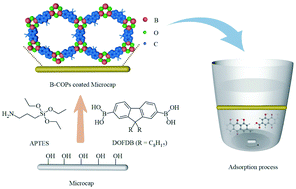Facile synthesis and immobilization of boroxine polymers containing carbon chains and their application as adsorbents†
Abstract
Boron-based covalent organic polymers are extremely popular adsorbents owing to their good adsorption properties. It is important and challenging to immobilize adsorbents on a substrate platform for their further application. In this study, boroxine-linked COPs (B-COPs) containing carbon chains were synthesized and immobilized on a microcap following a one-step solvent-thermal reaction. We used (3-aminopropyl)triethoxysilane to stabilize and catalyze the formation of boroxine rings, which also anchored B-COPs to the microcaps. To evaluate its adsorption property, the B-COP coated microcap (B-COPs@microcap) was subjected to novel stir bar sorptive extraction (SBSE) for separating the active anthraquinones from the complex matrices. Furthermore, the suspended B-COPs@microcap eliminated the mechanical abrasion of the adsorbed phase during the SBSE process. Highly sensitive detection of rhein and emodin was achieved with a low limit of detection (0.006 ng mL−1) by coupling the bar sorptive extraction (BSE) with ultra-performance liquid chromatography (UPLC). The B-COPs@microcap exhibited good reproducibility, selectivity, and recyclability.



 Please wait while we load your content...
Please wait while we load your content...